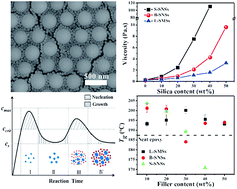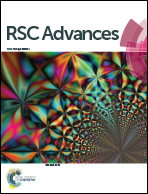One-pot synthesis of bimodal silica nanospheres and their effects on the rheological and thermal–mechanical properties of silica–epoxy composites†
Abstract
Due to the unique properties of nanoparticles, such as small size, large specific surface area and special optical performance, nanosilica is a promising candidate for replacing the conventional micron-sized silica to reinforce the performance of epoxy resins in microelectronic industries. But, its intensive inclination to form agglomerates in epoxy matrices, and its negative effects on the viscosity and glass transition temperature (Tg) of epoxy resins have limited its applications. In this work, a silica hybrid composed of sub-micron sized (500 ± 50 nm) and nano-sized (60 ± 10 nm) silica spheres was prepared and introduced into an epoxy polymer matrix. With this type of silica hybrid as a reinforcing filler, the dispersion quality of the nanosilica particles into the epoxy matrix was greatly improved due to the de-agglomeration effect of the large silica spheres. Also, the Tg of the epoxy composites was significantly enhanced while the viscosity of the liquid epoxy composites before curing remained lower at high filler loading as compared to the corresponding single-sized nanosilica filled epoxy nanocomposites.


 Please wait while we load your content...
Please wait while we load your content...